
Much of our discussion on national security during this election has revolved around terrorism and how to deal with ISIS. The United States and Russia have come to an agreement on how they will contend with the latter, but experts are pointing to North Korea as the true threat for the future. President Obama and Hillary Clinton both condemned the dictatorship’s latest test, while GOP presidential nominee used it as an avenue to criticize Hillary Clinton. But for those keeping a close eye on North Korea’s missile testing and nuclear program, the threat from North Korea may need more than just typical condemnation.
According to The New York Times, North Korea is edging closer and closer to manufacturing a missile that could reach the United States, and the next president will be the decider in how the nation will respond:
“They’ve greatly increased the tempo of their testing — in a way, showing off their capabilities, showing us images of ground tests they could have kept hidden,” John Schilling, an aerospace engineer and expert on North Korea’s missile program, said in an interview on Friday. “This isn’t something that can be ignored anymore. It’s going to be a high priority for the next president.”
Military experts say that by 2020, Pyongyang will most likely have the skills to make a reliable intercontinental ballistic missile topped by a nuclear warhead. They also expect that by then North Korea may have accumulated enough nuclear material to build up to 100 warheads.
The Times report notes that North Korea’s missile program is built on the back of Soviet technology and experts that moved to the country following the end of the Cold War. The fall of the Soviet Union reportedly accelerated the dictatorship’s development of rocket technology after many scientists left Russia to find work:
Pyongyang obtained its first wave of Russian rocket technology in the 1980s, giving it an ability to make Scuds, short-range missiles with engines that burn kerosene and emit smoky exhaust. Soon, the collapse of the Soviet rocket industry brought North Korea a second wave of far more potent technology.
The collapse began late in the Cold War as arms agreements led to deep cuts in both Soviet and American nuclear forces. It accelerated when Russia was unable to create a private industry for putting commercial satellites into orbit. Soon, impoverished rocket designers were fleeing Russia.
In one incident in late 1992, officials at a Moscow airport blocked a group of nearly two dozen missile experts, along with their wives and children, from traveling to Pyongyang, the North Korean capital. “I have always believed that our work is the most important,” Yuri Bessarabov, one of the rocket scientists, told Moscow News. “But it has turned out that we are unnecessary.”
The experts cited in the Times piece paint a grim future for North Korea’s relationship with the rest of the world. The 2020 date in the report is truly frightening, especially considering the recent Pentagon reports claiming the DPRK could potentially attach a nuclear weapon to a missile and reach the continental United States. Jeffrey Lewis of the Middlebury Institute for International Studies at Monterey takes this a step further according to the Times, noting that the nation could soon create a missile that could reach Washington D.C. or New York in due time.
A comforting note in the report is that there are many aspects of North Korea’s missile program that are still lacking, including the ability to ensure a missile can survive the extreme conditions of our atmosphere. The chances of any successful ICBM test in the next few years is low, but military officials still claim that it will be “critical” for the United States to reassess their policy towards the nation in the near future according to The Times:
“The intel community assesses North Korea’s ability to successfully shoot an ICBM with a nuclear weapon and reach the homeland as low,” William E. Gortney, commander of North American Aerospace Defense Command, told a subcommittee of the Senate Armed Services Committee in April.
Eventually, he added, “we assess that this low probability will increase,” and the United States will need to invest in better defenses.
This is just another layer to the importance of this election and the decisions that will need to be made within the next term and beyond. Who will be the best to make these decisions?
(Via The New York Times)
